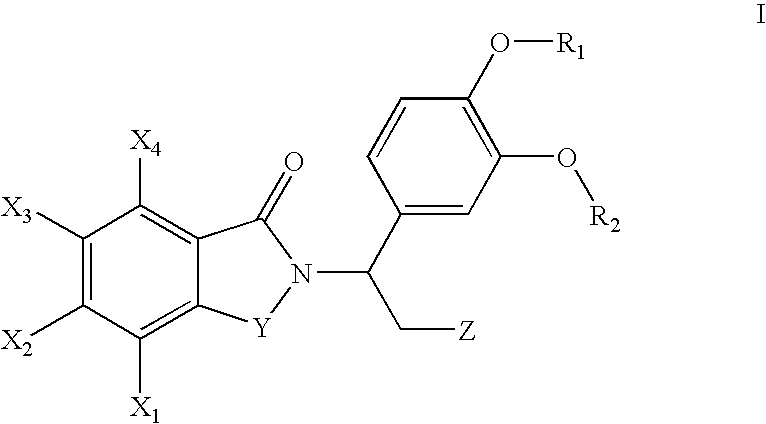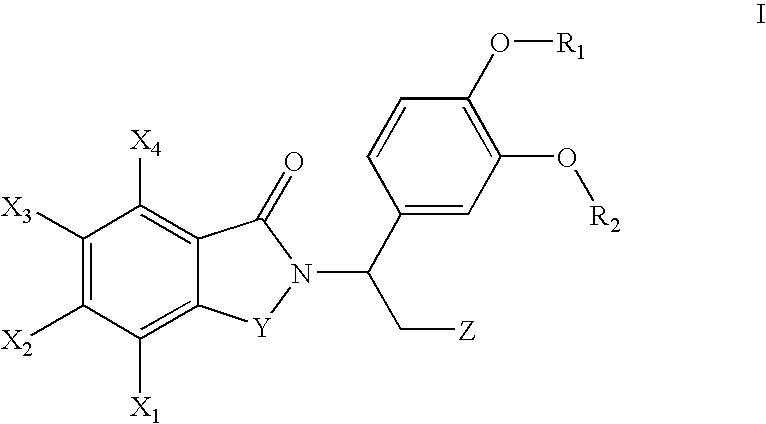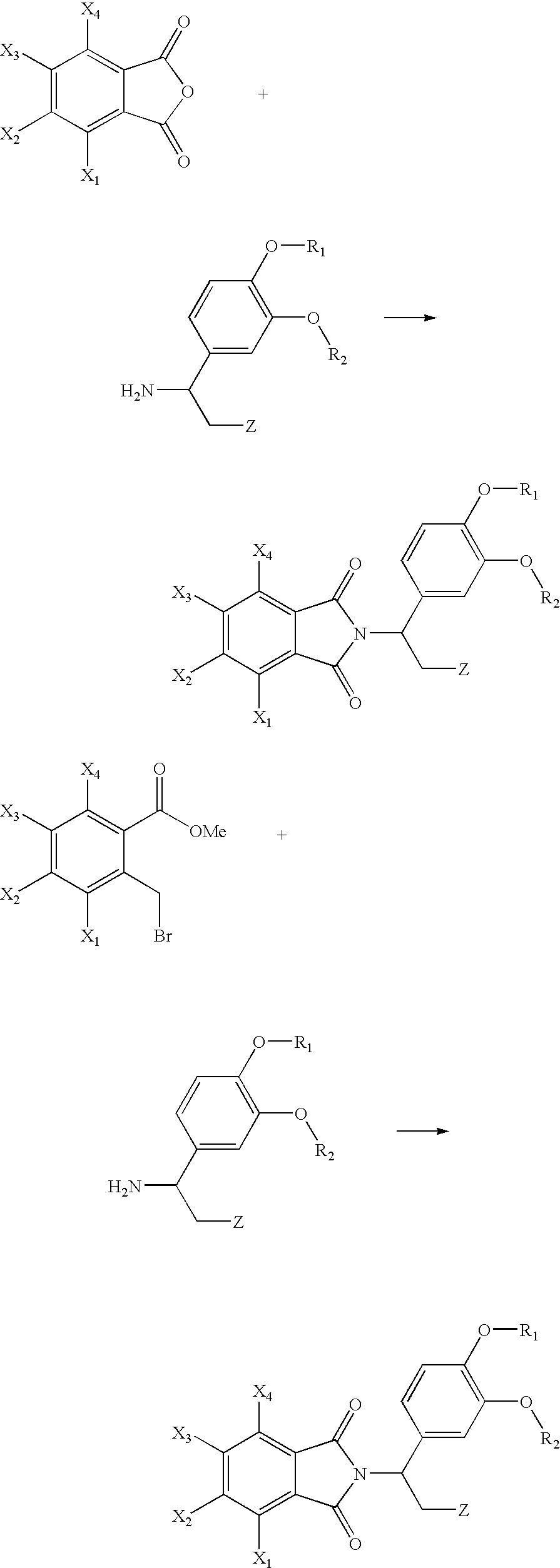Fluoroalkoxy-substituted 1,3-dihydro-isoindolyl compounds and their pharmaceutical uses
a technology of isoindolyl and fluoroalkoxy, which is applied in the field of fluoroalkoxysubstituted 1, 3dihydroisoindolyl compounds, can solve the problems of limited effectiveness and break down of camp control in these cells, and achieve the effects of reducing the probability, eliminating the possibility, and reducing the risk of subjects
- Summary
- Abstract
- Description
- Claims
- Application Information
AI Technical Summary
Benefits of technology
Problems solved by technology
Method used
Image
Examples
example 1
5.1 Example 1
4-Difluoromethoxy-3-hydroxy-benzaldehyde
[0176] 4
[0177] A vigorously stirred mixture of 3,4-dihydroxybenzaldehyde (25 g, 0.18 mol) and potassium carbonate (25 g 0.18 mol) in dimethylformamide (125 ml) was heated under an atmosphere of chlorodifluoromethane using a -78.degree. C. condenser at 100.degree. C. for 5.5 hours. The mixture was allowed to cool, was acidified to pH 5-6 with concentrated hydrochloric acid and was concentrated under reduced pressure. The residue was partitioned between ether and 3N aqueous hydrochloric acid and extracted five times with ether. The organic extract was dried over magnesium sulfate and the solvent was removed in vacuo. The residue was purified by flash chromatography, eluting with 2:1 hexane / ethyl acetate, to provide a yellow solid, which was triturated with ethyl acetate / hexane to give 4-difluoromethoxy-3-hydroxy-benzaldehyde as a white solid (5 g, 15%). .sup.1HNMR (DMSO-d.sub.6): .delta. 7.22 (t, J.sub.H-F=75 Hz, 1H), 7.31 (d, J=10 ...
example 2
5.2 Example 2
3-Cyclopropylmethoxy-4-difluoromethoxy-benzaldehyde
[0178] 5
[0179] To a mixture of 4-difluoromethoxy-3-hydroxy-benzaldehyde (5.0 g, 27 mmol) and potassium carbonate (5.5 g, 40 mmol) in dimethylformamide (30 ml) under inert atmosphere at 60.degree. C. was added bromoethylcyclopropane (5 g, 37 mmol). The mixture was stirred and heated at 65.degree. C. After 1.5 hour, the mixture was allowed to cool and was filtered. The filtrate was concentrated under reduced pressure. The mixture was extracted with ethyl acetate (2.times.25 ml) and water (25 ml). The organic layer was washed with water (25 ml), brine (25 ml) and dried over magnesium sulfate. The solvent was removed in vacuo to give 3-cyclopropylmethoxy-4-difluoromethoxy-benzaldehyde as an oil (6.4 g, 100%). .sup.1HNMR (CDCl.sub.3): .delta. 0.38-0.44 (m, 2H), 0.62-0.75 (m, 2H), 1.15-1.36 (m, 1H), 3.98 (d, J=4.5 Hz, 2H), 6.78 (t, J.sub.H-F=75 Hz, 1H), 7.30-7.50 (m, 3H), 9.96 (s, 1H).
example 3
5.3 Example 3
3-amino-3-(3-cyclopropylmethoxy-4-difluoromethoxy-phenyl)-propionic acid
[0180] 6
[0181] To a mixture of 3-cyclopropylmethoxy-4-difluoromethoxy-benzaldehyde (6.4 g, 27 mmol) and ammonium acetate (4.3 g, 55 mmol) in 95% ethanol (30 ml) under nitrogen atmosphere at 40.degree. C. was added malonic acid (2.9 g, 28 mrnmol). The mixture was stirred and heated at reflux temperature for 20 hours. The mixture was allowed to cool and was filtered to give 3-cyclopropylmethoxy-4-difluoromethoxy-benzaldehyde as a white solid (4.3 g, 52%). .sup.1HNMR (DMSO-d.sub.6): .delta. 0.31-0.35 (m, 2H), 0.52-0.58 (m, 2H), 1.15-1.36 (m, 1H), 2.33-2.37 (m, 2H), 3.87 (d, J=7.5 Hz, 2H), 4.20-4.26 (m, 1H), 6.94-6.98 (m, 1H), 7.03 (t, J.sub.H-F=75 Hz, 1H), 7.13 (d, J=10 Hz, 1H), 7.23 (d, J=2.5 Hz, 1H).
PUM
| Property | Measurement | Unit |
|---|---|---|
| Mass | aaaaa | aaaaa |
| Mass | aaaaa | aaaaa |
| Mass flow rate | aaaaa | aaaaa |
Abstract
Description
Claims
Application Information
 Login to View More
Login to View More - R&D
- Intellectual Property
- Life Sciences
- Materials
- Tech Scout
- Unparalleled Data Quality
- Higher Quality Content
- 60% Fewer Hallucinations
Browse by: Latest US Patents, China's latest patents, Technical Efficacy Thesaurus, Application Domain, Technology Topic, Popular Technical Reports.
© 2025 PatSnap. All rights reserved.Legal|Privacy policy|Modern Slavery Act Transparency Statement|Sitemap|About US| Contact US: help@patsnap.com



